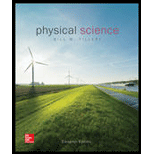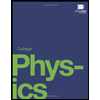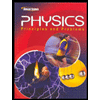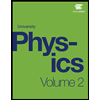
Electrostatic charge results from
a. transfer or redistribution of electrons.
b. gain or loss of protons.
c. separation of charge from electrons and protons.
d. failure to keep the object clean of dust.
The source of electrostatic charges, from the following options.
Transfer or redistribution of electrons.
Gain or loss of protons.
Separation of charge from electrons and protons.
Failure to keep the object clean of dust.
Answer to Problem 1AC
Solution:
Option (a) is the correct option.
Explanation of Solution
Introduction:
Electrostatic charges mean charges at rest on any insulated body.
Explanation:
Reason for the correct option:
Electrostatic charges are produced when there is a transfer of electrons from one body to another via some method like rubbing, electrical discharge.
Example:In real life situation, upon rubing a comb on the head for some time and then immediately placing the comb near some bits of paper, it can be seen that the comb attracts the bits of paper, and paper sticks to comb for some time.
The reason for this is the transfer of electrons from the comb to hair. This makes the comb charged and hence it attracts the paper.
Hence, option (a) is correct option.
Reason for the incorrect options:
Option (b) is incorrect because in an atom only electrons are mobile and can transfer from one body to another. Protons are embedded in the nucleus, hence not mobile.
Option (c) is incorrect because charge gets never separated from protons. Electrons themselves get transferred from one body to another body.
Option (d) is incorrect because dust is nowhere related to the science of electrostatics. So it’s meaningless.
Hence, options (b), (c) and (d) are incorrect.
Conclusion:
Hence, the electrostatic charges result from the transfer and redistribution of electrons.
Want to see more full solutions like this?
Chapter 6 Solutions
Physical Science
- Are you relatively safe from lightning inside an automobile? Give two reasons.arrow_forwardWhat net charge would you place on a 100 g piece of sulfur if you put an extra electron on 1 in 1012 of its atoms? (Sulfur has an atomic mass of 32.1.)arrow_forwardWhat is the magnitude and direction of an electric field that exerts a 2.0010-5 N upward force on a -1.75 C charge?arrow_forward
- Why do most objects tend to contain nearly equal numbers of positive and negative charges?arrow_forwardA certain five cent coin contains 5.00 g of nickel. What fraction of the nickel atoms’ electrons, removed and placed 1.00 m above it, would support the weight of this coin? The atomic mass of nickel is 53.7, and each nickel atom contains 28 electrons and 28 protonsarrow_forward(a) Common transparent tape becomes charged when pulled from a dispenser. If one piece is placed above another, the repulsive force can be great enough to support the top piece’s weight. Assuming equal point charges (only an approximation), calculate the magnitude of the charge if electrostatic force is great enough to support the weight of a mg piece of tape held 1.00 cm above another. (b) Discuss whether the magnitude of this charge is consistent with what is typical of static electricity.arrow_forward
- Compare the law of charges and the law of poles.arrow_forwardWhat is the magnitude and direction of the force exerted on a 3.50 /C charge by a 250 N/C electric field that points due east?arrow_forwardHow far apart must two point charges of 75.0 nC (typical of static electricity) be to have a force of 1.00 N between them?arrow_forward
- Sketch the electric field between the two conducting plates shown in Figure 18.50, given the top plate is positive and an equal amount of negative charge is on the bottom plate. Be certain to indicate the distribution of charge on the plates.arrow_forwardA certain lightning bolt moves 40.0 C of charge. How many fundamental units of charge | qe\ is this?arrow_forwardWhat is the force on the charge located at x = 8.00 cm in Figure 18.52(a) given that q = 1.00 C?arrow_forward
 College PhysicsPhysicsISBN:9781938168000Author:Paul Peter Urone, Roger HinrichsPublisher:OpenStax College
College PhysicsPhysicsISBN:9781938168000Author:Paul Peter Urone, Roger HinrichsPublisher:OpenStax College Glencoe Physics: Principles and Problems, Student...PhysicsISBN:9780078807213Author:Paul W. ZitzewitzPublisher:Glencoe/McGraw-Hill
Glencoe Physics: Principles and Problems, Student...PhysicsISBN:9780078807213Author:Paul W. ZitzewitzPublisher:Glencoe/McGraw-Hill
 An Introduction to Physical SciencePhysicsISBN:9781305079137Author:James Shipman, Jerry D. Wilson, Charles A. Higgins, Omar TorresPublisher:Cengage Learning
An Introduction to Physical SciencePhysicsISBN:9781305079137Author:James Shipman, Jerry D. Wilson, Charles A. Higgins, Omar TorresPublisher:Cengage Learning



